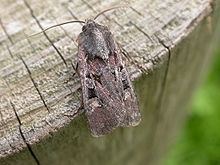Scientific name Euxoa obelisca | Tribe Agrotini Rank Species | |
 | ||
Similar Euxoa (Euxoa) tritici, Garden dart, Euxoa, Euxoa recussa, Euxoa temera | ||
Euxoa obelisca, the square-spot dart, is a moth of the family Noctuidae. It is found in the Palearctic ecozone (Europe, Central Asia, North Africa Asia minor).
Contents
Technical description and variation
Forewing purplish brown; costa pale to outer line: cell dark brown; stigmata large, greyish ochreous: the claviform dark; hindwing in male white, with narrow grey shade along margin, in female more or less grey-tinged throughout.- in ab. fictilis Hbn. the forewing is more variegated, the submarginal line preceded by a row of distinct black teeth; - ab. ruris Hbn. , larger than typical, reddish grey or reddish brown, with or without the pale costa: stigmata large and pale: - ab. villiersii Guen. is also larger than typical; forewing ochreous grey with costa and both stigmata whitish, darker in the female; — ab. plectoides Guen. the same size as type, forewing with more acute apex, deep shining violet brown, with traces of subterminal only: costa and stigmata (which are small) pale testaceous; the orbicular somewhat angulated, the reniform constricted in middle: claviform obsolete: the cell deep black; hindwing very dark; described from a female only from Lapland; omitted by Staudinger, but probably a distinct species: a very distinct form from the Urals, which may be called ab. carbonis nov.[Warren] has the ground colour purplish black, with the costal streak and upper stigmata pale and the cell deep black: all the lines indistinct: several examples of both sexes sent from Uralsk by M. Bartel.
Biology
The moth flies from July to October depending on the location.
The larvae feed on various herbaceous plants, such as Helianthemum nummularium and Galium species.
